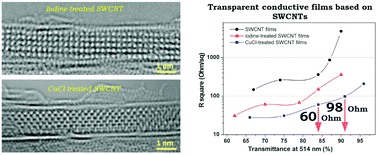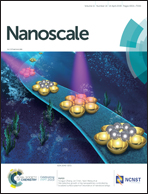Films of filled single-wall carbon nanotubes as a new material for high-performance air-sustainable transparent conductive electrodes operating in a wide spectral range
Abstract
In this paper we show the advantages of transparent high conductive films based on filled single-wall carbon nanotubes. The nanotubes with internal channels filled with acceptor molecules (copper chloride or iodine) form networks demonstrating significantly improved characteristics. Due to the charge transfer between the nanotubes and filler, the doped-nanotube films exhibit a drop in electrical sheet resistance of an order of magnitude together with a noticeable increase of film transparency in the visible and near-infrared spectral range. The thermoelectric power measurements show a significant improvement of air-stability of the nanotube network in the course of the filling procedure. For the nanotube films with an initial transparency of 87% at 514 nm and electrical sheet resistance of 862 Ohm sq−1 we observed an improvement of transparency up to 91% and a decrease of sheet resistance down to 98 Ohm sq−1. The combination of the nanotube synthesis technique and molecules for encapsulation has been optimized for applications in optoelectronics.



 Please wait while we load your content...
Please wait while we load your content...